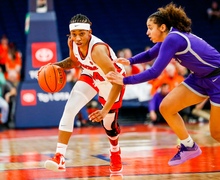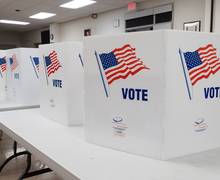Q&A: Professor discusses printmaking art exhibit
Kevin Larmon, a professor of art, design and transmedia in the College of Visual and Performing Arts, is also a student in the printmaking MFA program. He and eight other multi-disciplinary students produced artwork for A Long History Cut Short, an exhibition housed at the Point of Contact Gallery in the Nancy Cantor Warehouse. The exhibit’s closing reception will be Thursday at 6 p.m. The Daily Orange sat down with Larmon to get a better idea about what the exhibit features.
The Daily Orange: What was the overall goal of the exhibition?
Kevin Larmon: Dusty Herbig is the professor of the class, and Dusty is all about pushing the boundaries of printmaking, which I think is kind of necessary to do because printmaking is such an ancient art form that it needs to be updated or pushed a bit. Dusty’s idea for the show was to have us explore the different ways to do printmaking and push it further along.
The D.O.: What makes printmaking unique and how is the class pushing it into the 21st century?
K.L.: It was first made to produce cheap multiples of famous paintings. An artist could sell things — I wouldn’t say for cheap — but less expensive than a painting or an original drawing. It’s starting to be used now, especially in this class, as a tool to help make art like sculptures. I used it in my paintings as an under layer so I feel like it’s kind of being used as a part of peoples’ way of making things.
The D.O.: Describe the piece that you entered and the process it took you to make it.
K.L.: I have four pieces in this exhibition. I’ve always incorporated, well, usually it’s gay pornography or art history underneath my paintings, and I always use anonymous stuff. I would have bits and pieces of flesh show, and it would be very hard to tell if it was art history or pornography. I started realizing I could also make my own prints. My partner and I started taking macro photos of body hair and tattoos and that became the print under those paintings. It’s much more personal about sexual identity.
The D.O.: How does the exhibition compare to others in the past you’ve been in as a painter?
K.L.: To me it’s a really contemporary exhibition. I feel like the title that we came up with totally fits my work. When I came to New York and when I started showing and getting recognition is when the AIDS epidemic first hit. A lot of my work had been about loss and the virus. The images you see on my paintings are more cellular, based on paintings of cells or viruses. To me, when I see this exhibition, I feel it’s very much like an exhibition that I would have organized myself. I feel very proud. There’s a bunch of great artists in this show. The students are so smart and help me develop my art. There’s a mutual thing going on — it’s great for me to get input from these younger artists that I feel like they are expressing similar issues in their work.
The D.O.: Why is the exhibition titled “A Long History Cut Short?”
K.L.: We came into class with different titles and we all thought this was a provocative and interesting title. It’s sort of about printmaking and that the history has been changed at this point. I’ve always been working about loss and memory — the ideas of things like viruses and cells mutating to end a life or end something. To me it felt very personal. I think it just felt intuitively right. There’s really kind of heavy stuff in it. It’s beautiful and I’m very proud of being in it.
The D.O.: Do you think overall the show was effective in its message?
K.L.: Yes, I think if you go there and expect to see traditional prints, you’re not going to see them. You’re going to see art where you’re wondering, and you know there’s print involved but it just becomes part of the art. That’s Dusty’s point. It’s the idea that printmaking can inform and help you develop your work, but it’s not the most prominent part.
Published on January 15, 2015 at 12:01 am
Contact Kait: kehobson@syr.edu





